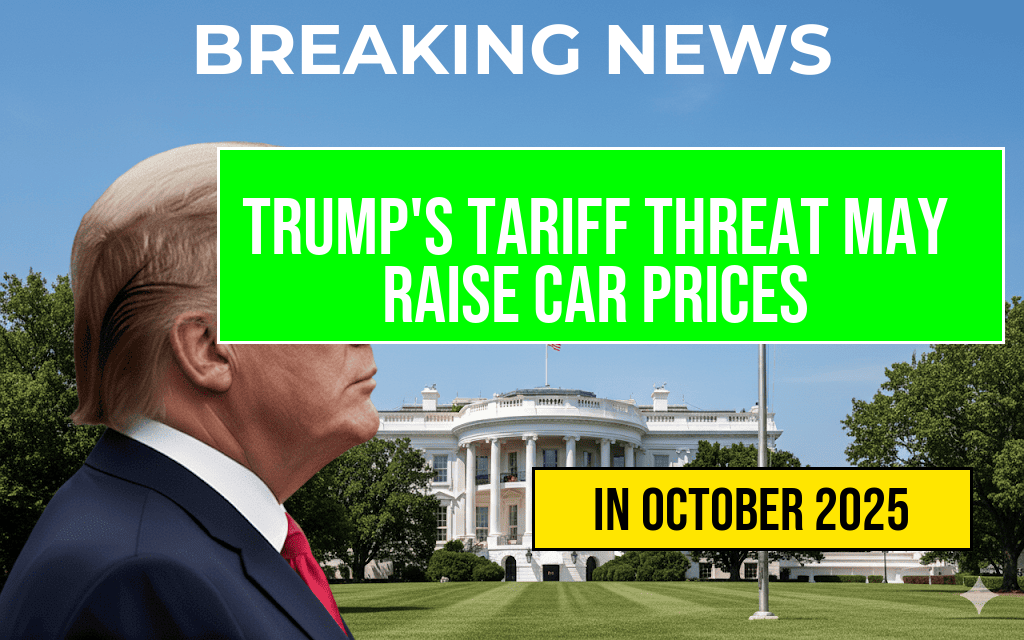President Donald Trump’s recent announcement of potential tariffs targeting imported vehicles has sent ripples through the automotive industry, consumers, and market analysts alike. The proposed tariffs could impose additional costs on foreign-made vehicles, potentially increasing the average price of new cars by as much as $5,286. This move, if enacted, would mark a significant shift in trade policy, aiming to bolster domestic manufacturing but raising concerns over consumer affordability and supply chain stability. Automakers and industry experts warn that these tariffs could lead to a surge in vehicle prices, impacting both the new car market and the broader economy.
Background on the Tariff Proposal
Origins and Political Context
The tariff threat originates from ongoing trade negotiations and concerns over national security, intellectual property, and unfair trade practices. President Trump has previously used tariffs as leverage to renegotiate trade agreements, pressuring countries like China and Mexico. The latest focus on the automotive sector stems from allegations that certain foreign automakers benefit from unfair subsidies, giving them an edge in the U.S. market.
According to the Office of the United States Trade Representative (USTR), the proposed tariffs could be imposed on imported vehicles and auto parts, with rates potentially reaching 25%. Such a move aims to protect American automakers like Ford, General Motors, and Stellantis, which have faced increasing competition from international counterparts.
For more on U.S. trade policies, see United States trade policy.
Projected Impact on Vehicle Prices
Price Increases and Consumer Costs
Industry analysts estimate that a 25% tariff could add approximately $2,000 to $5,286 to the cost of an average new vehicle, depending on the model and manufacturer. The range accounts for variations in vehicle size, import origin, and manufacturer pricing strategies. Consumers seeking mid-priced sedans, SUVs, and trucks could see significant hikes in sticker prices, making new car ownership less affordable for many Americans.
According to data from automotive research firm JD Power, the average price of a new vehicle in the U.S. was around $48,000 in 2023. An additional $5,286 could push some models well above the $50,000 threshold, influencing purchasing decisions and potentially dampening sales figures.
Impact on Dealerships and Supply Chains
Dealerships could face increased costs, which might be passed onto consumers or absorbed, eroding profit margins. Additionally, automakers relying heavily on imported parts may experience production delays or increased costs, further complicating the supply chain. Smaller manufacturers and foreign automakers operating in the U.S. could bear the brunt of these tariffs, potentially reducing their market share or prompting price adjustments.
Industry Response and Market Outlook
Automaker Reactions
- General Motors expressed concern over the potential impact on vehicle affordability and warned that tariffs could lead to job cuts and reduced investment in the U.S.
- Toyota highlighted the risk of increased costs leading to decreased competitiveness in the American market.
- Ford emphasized the importance of free trade and cautioned against tariffs that could disrupt the supply chain and hinder innovation.
Market Dynamics and Consumer Behavior
Analysts anticipate that higher vehicle prices could slow new car sales, especially among budget-conscious consumers. Used car markets might see increased demand as buyers seek more affordable alternatives, which could distort pricing and availability further. The potential for prolonged trade tensions also adds uncertainty for automakers planning future investments and product launches.
Economic and Policy Considerations
Broader Economic Implications
| Scenario | Estimated Price Increase | Potential Consumer Impact |
|---|---|---|
| Moderate Tariffs (15%) | $2,000–$3,000 | Moderate increase in vehicle prices, possible slowdown in sales |
| High Tariffs (25%) | $4,000–$5,286 | Significant price hikes, reduced affordability, potential shift to used vehicles |
Policy Outlook
Legislators and industry stakeholders are closely monitoring the situation, with some urging the administration to reconsider tariffs that could harm consumers and the broader economy. Critics argue that such measures may trigger retaliatory tariffs from trading partners, escalating into a trade war that could dampen economic growth and employment in manufacturing sectors.
For consumers and industry players alike, the unfolding trade policy decisions remain a critical factor influencing the automotive landscape in the coming months. As negotiations continue, the potential for increased vehicle prices underscores the importance of balanced trade policies that protect American industries without burdening consumers.
For more on trade policy impacts, visit Forbes or review detailed analysis at Wikipedia’s entry on trade wars.
Frequently Asked Questions
What is the main concern regarding Trump’s tariff threat on new cars?
The main concern is that Trump’s tariff threat could lead to an increase in vehicle prices by up to $5,286, making new cars more expensive for consumers.
How could tariffs impact the overall cost of new vehicles?
Tariffs on imported auto parts and vehicles could raise manufacturing costs, which automakers may pass on to buyers, resulting in higher vehicle prices.
Which vehicles are most affected by potential tariffs?
Imported foreign-made cars and auto parts are most susceptible to tariff impacts, potentially increasing the costs of a wide range of vehicles sold in the U.S.
Could tariffs lead to a decrease in vehicle availability?
Yes, increased tariffs might cause automakers to reduce inventory or delay production, possibly leading to shortages or longer wait times for consumers.
What should consumers consider in response to this news?
Consumers should stay informed about tariff developments and consider buying decisions accordingly, as potential price increases could affect budget planning for new vehicles.

Leave a Reply